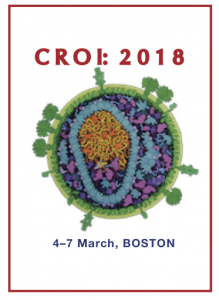Isoniazid preventive TB therapy in pregnancy and postpartum: recommendations now need to be re-evaluated
16 April 2018. Related: Conference reports, Women's health, Pregnancy, TB coinfection, CROI 25 (Retrovirus) 2018.
 Polly Clayden, HIV i-Base
Polly Clayden, HIV i-Base
Isoniazid preventive therapy during and pregnancy and postpartum in HIV positive women receiving ART in high-burden TB settings led to serious adverse events with no reduction in TB cases, according to findings from IMPAACT P1078/TB APPRISE.
Adverse pregnancy outcomes were higher among women starting isoniazid (INH) preventative therapy (IPT) in pregnancy compared with postpartum in the study. These data were presented as a late breaker by Amita Gupta at CROI 2018.
IPT is currently recommended by WHO for people with HIV who are at high risk of TB with strong evidence, based on over 10 randomised trials. IPT is also recommended for pregnant HIV positive women but informed by weak evidence as not a single IPT trial included them. Previous data has found INH to be associated with increased liver damage in pregnant and postpartum women.
The IMPAACT P1078 investigators hypothesised that IPT can be safely started during pregnancy in HIV positive women.
This was a phase 4 double-blind, placebo-controlled, non-inferiority trial that randomised women to start IPT for 28 weeks either in pregnancy (immediate arm) or at 12 weeks postpartum (deferred arm) in HIV positive women from TB-endemic areas in Africa, Asia, and Haiti. There were 13 sites across eight countries.
Women were randomised 1:1 to either INH (300mg daily) for 28 weeks followed by placebo or to placebo until week 12 postpartum then INH for 28 weeks. Mother-infant pairs were followed to week 48 postpartum. Safety evaluations were every four weeks.
The primary endpoint was treatment-related maternal adverse events grade 3 or higher/permanent drug discontinuation due to toxicity. Secondary outcomes were maternal hepatotoxicity, maternal/infant death, TB, adverse pregnancy outcomes, and infant adverse events.
The non-inferiority margin was an incidence rate of 5/100 person-years (PY), assuming a 5/100 PY incident rate in the deferred arm (based on data in non-pregnant HIV positive adults).
Of 956 women enrolled (477 immediate and 479 deferred arms), 93% were black and 7% Asian. Median age was 29 years and CD4 493 cells/mm3. Almost all (955) were on ART (85% efavirenz-based) and 63% had undetectable viral load. Approximately a third had latent TB. Approximately two thirds of women were enrolled at 24 to 34 weeks gestation and the remainder at 14 to 24 weeks. Median follow-up was 58.6 weeks.
In intent to treat analysis, 147 women (15%) reached the primary endpoint: 74 and 73 in the immediate and deferred arms respectively. Incidence rates were 15.4 and 14.9 per 100PY, respectively: IRD 0.5 (95% CI: –4.4 to +5.4).
Grade 3 and above maternal adverse events occurred in 145/477 (30.5%) and 136/479 (28.4%): IRD 4.2 (95% CI: –3.6 to +12.0).
Overall, 45 women permanently discontinued due to toxicity: 35 protocol-defined toxicity; nine non protocol-defined low-grade toxicity and one women died due to toxicity. Almost all were liver function adverse events.
There were six maternal deaths (two in the immediate and four in the deferred IPT arms). All occurred after delivery (at 5, 5, 7, 12, 19 and 40 weeks). Four deaths were due to hepatotoxicity, two were judged to be related to INH. All women were receiving efavirenz-based ART.
After a review of the first two deaths, the DSMB requested a participant letter providing explicit information about signs and symptoms of hepatotoxicity and the risk of death from INH and ART. This led to 77 (8%) women withdrawing consent before the study was completed.
Overall, adverse pregnancy outcomes were significantly higher in the immediate vs deferred arm: 23% vs 17%, p=0.009. These were largely driven by foetal death and low birth weight.
A total of 380 infants (42%) had grade 3 or 4 adverse events with no significant differences by treatment arm.
Maternal and infant TB incidence were very low: 0.6% and 0.2% respectively, with no significant differences by treatment arm.
Dr Gupta concluded that adverse events were higher than expected, at least possibly attributed to INH in both arms. The non-inferiority margin was not reached for the primary maternal safety endpoint, so the investigators could not confirm that INH is safe for the mother. She noted that they did not find significant differences in maternal hepatotoxicity, grade 3 and above infant adverse events or maternal infant death between immediate and deferred IPT.
But adverse pregnancy outcomes were more frequent with IPT during pregnancy. And timing of IPT did not affect TB risk. The conclusions included a suggestion that current WHO guidelines on IPT in pregnancy for HIV positive women receiving ART now need re-evaluation to weigh the risks and benefits.
comment
This is a cautionary tale.
Although IPT is recommended for this population, IMPAACT P1078 is the first randomised trial of TB prevention in HIV positive pregnant and postpartum women at high risk of TB.
Once again these findings highlight the importance of earlier inclusion of pregnant women in clinical trials. Not doing so can lead to risky recommendations or delayed roll out of potentially beneficial new treatments to the general population – as we are seeing with dolutegravir.
Reference
Gupta A et al. Randomised trial of safety of isoniazid preventive therapy during or after pregnancy. 25th CROI. Boston. 4–7 March 2018. Oral abstract 142LB.
www.croiconference.org/sessions/randomized-trial-safety-isoniazid-preventive-therapy-during-or-after-pregnancy (abstract)
www.croiwebcasts.org/console/player/37314 (webcast)

